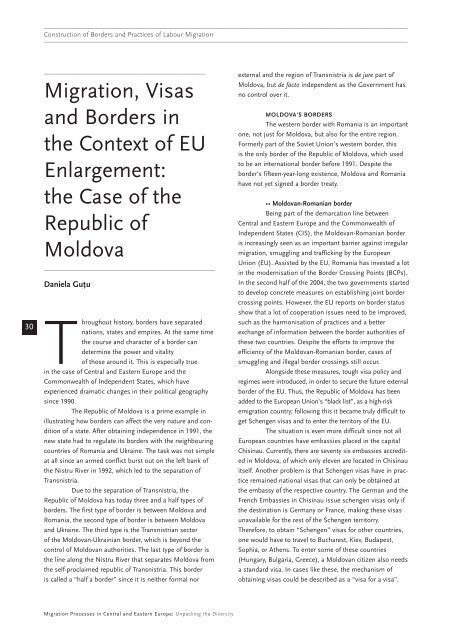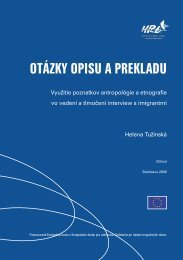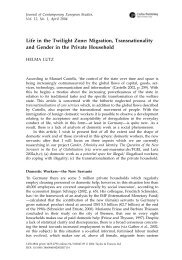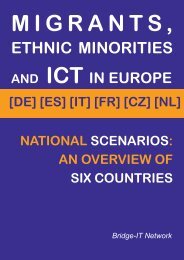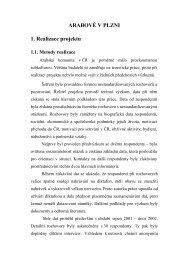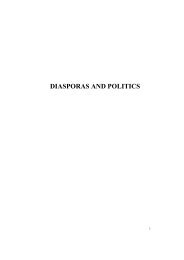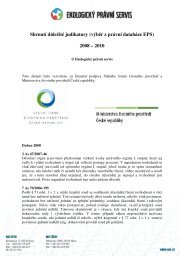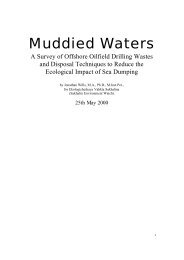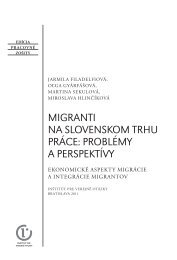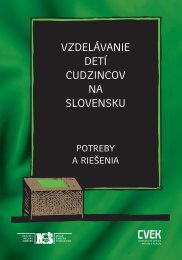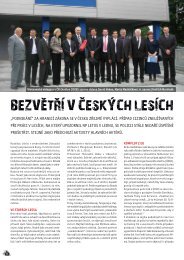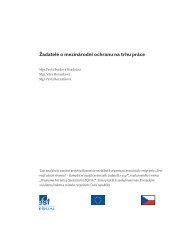Migration Processes in Central and Eastern Europe - Multiple Choices
Migration Processes in Central and Eastern Europe - Multiple Choices
Migration Processes in Central and Eastern Europe - Multiple Choices
You also want an ePaper? Increase the reach of your titles
YUMPU automatically turns print PDFs into web optimized ePapers that Google loves.
———————————————————————————————————————————————————————————————<br />
Construction of Borders <strong>and</strong> Practices of Labour <strong>Migration</strong><br />
———————————————————————————————————————————————————————————————<br />
30<br />
————————————————————————————<br />
<strong>Migration</strong>, Visas<br />
<strong>and</strong> Borders <strong>in</strong><br />
the Context of EU<br />
Enlargement:<br />
the Case of the<br />
Republic of<br />
Moldova<br />
—————————————————————————————<br />
Daniela Gut‚u<br />
Throughout history, borders have separated<br />
nations, states <strong>and</strong> empires. At the same time<br />
the course <strong>and</strong> character of a border can<br />
determ<strong>in</strong>e the power <strong>and</strong> vitality<br />
of those around it. This is especially true<br />
<strong>in</strong> the case of <strong>Central</strong> <strong>and</strong> <strong>Eastern</strong> <strong>Europe</strong> <strong>and</strong> the<br />
Commonwealth of Independent States, which have<br />
experienced dramatic changes <strong>in</strong> their political geography<br />
s<strong>in</strong>ce 1990.<br />
The Republic of Moldova is a prime example <strong>in</strong><br />
illustrat<strong>in</strong>g how borders can affect the very nature <strong>and</strong> condition<br />
of a state. After obta<strong>in</strong><strong>in</strong>g <strong>in</strong>dependence <strong>in</strong> 1991, the<br />
new state had to regulate its borders with the neighbour<strong>in</strong>g<br />
countries of Romania <strong>and</strong> Ukra<strong>in</strong>e. The task was not simple<br />
at all s<strong>in</strong>ce an armed conflict burst out on the left bank of<br />
the Nistru River <strong>in</strong> 1992, which led to the separation of<br />
Transnistria.<br />
Due to the separation of Transnistria, the<br />
Republic of Moldova has today three <strong>and</strong> a half types of<br />
borders. The first type of border is between Moldova <strong>and</strong><br />
Romania, the second type of border is between Moldova<br />
<strong>and</strong> Ukra<strong>in</strong>e. The third type is the Transnistrian sector<br />
of the Moldovan-Ukra<strong>in</strong>ian border, which is beyond the<br />
control of Moldovan authorities. The last type of border is<br />
the l<strong>in</strong>e along the Nistru River that separates Moldova from<br />
the self-proclaimed republic of Transnistria. This border<br />
is called a “half a border” s<strong>in</strong>ce it is neither formal nor<br />
external <strong>and</strong> the region of Transnistria is de jure part of<br />
Moldova, but de facto <strong>in</strong>dependent as the Government has<br />
no control over it.<br />
MOLDOVA'S BORDERS<br />
The western border with Romania is an important<br />
one, not just for Moldova, but also for the entire region.<br />
Formerly part of the Soviet Union's western border, this<br />
is the only border of the Republic of Moldova, which used<br />
to be an <strong>in</strong>ternational border before 1991. Despite the<br />
border's fifteen-year-long existence, Moldova <strong>and</strong> Romania<br />
have not yet signed a border treaty.<br />
•• Moldovan-Romanian border<br />
Be<strong>in</strong>g part of the demarcation l<strong>in</strong>e between<br />
<strong>Central</strong> <strong>and</strong> <strong>Eastern</strong> <strong>Europe</strong> <strong>and</strong> the Commonwealth of<br />
Independent States (CIS), the Moldovan-Romanian border<br />
is <strong>in</strong>creas<strong>in</strong>gly seen as an important barrier aga<strong>in</strong>st irregular<br />
migration, smuggl<strong>in</strong>g <strong>and</strong> traffick<strong>in</strong>g by the <strong>Europe</strong>an<br />
Union (EU). Assisted by the EU, Romania has <strong>in</strong>vested a lot<br />
<strong>in</strong> the modernisation of the Border Cross<strong>in</strong>g Po<strong>in</strong>ts (BCPs).<br />
In the second half of the 2004, the two governments started<br />
to develop concrete measures on establish<strong>in</strong>g jo<strong>in</strong>t border<br />
cross<strong>in</strong>g po<strong>in</strong>ts. However, the EU reports on border status<br />
show that a lot of cooperation issues need to be improved,<br />
such as the harmonisation of practices <strong>and</strong> a better<br />
exchange of <strong>in</strong>formation between the border authorities of<br />
these two countries. Despite the efforts to improve the<br />
efficiency of the Moldovan-Romanian border, cases of<br />
smuggl<strong>in</strong>g <strong>and</strong> illegal border cross<strong>in</strong>gs still occur.<br />
Alongside these measures, tough visa policy <strong>and</strong><br />
regimes were <strong>in</strong>troduced, <strong>in</strong> order to secure the future external<br />
border of the EU. Thus, the Republic of Moldova has been<br />
added to the <strong>Europe</strong>an Union's “black list”, as a high-risk<br />
emigration country; follow<strong>in</strong>g this it became truly difficult to<br />
get Schengen visas <strong>and</strong> to enter the territory of the EU.<br />
The situation is even more difficult s<strong>in</strong>ce not all<br />
<strong>Europe</strong>an countries have embassies placed <strong>in</strong> the capital<br />
Chis<strong>in</strong>au. Currently, there are seventy six embassies accredited<br />
<strong>in</strong> Moldova, of which only eleven are located <strong>in</strong> Chis<strong>in</strong>au<br />
itself. Another problem is that Schengen visas have <strong>in</strong> practice<br />
rema<strong>in</strong>ed national visas that can only be obta<strong>in</strong>ed at<br />
the embassy of the respective country. The German <strong>and</strong> the<br />
French Embassies <strong>in</strong> Chis<strong>in</strong>au issue schengen visas only if<br />
the dest<strong>in</strong>ation is Germany or France, mak<strong>in</strong>g these visas<br />
unavailable for the rest of the Schengen territorry.<br />
Therefore, to obta<strong>in</strong> “Schengen” visas for other countries,<br />
one would have to travel to Bucharest, Kiev, Budapest,<br />
Sophia, or Athens. To enter some of these countries<br />
(Hungary, Bulgaria, Greece), a Moldovan citizen also needs<br />
a st<strong>and</strong>ard visa. In cases like these, the mechanism of<br />
obta<strong>in</strong><strong>in</strong>g visas could be described as a “visa for a visa”.<br />
<strong>Migration</strong> <strong>Processes</strong> <strong>in</strong> <strong>Central</strong> <strong>and</strong> <strong>Eastern</strong> <strong>Europe</strong>: Unpack<strong>in</strong>g the Diversity


